
How to Name Your Business: 8 Types of Names to Avoid
Your business’s name is one of the first impressions new customers have of your company. It’s your first chance to delight and intrigue them, as well as communicate the core value of the product or service you sell. And, based on how quickly people make long-term judgments of brands, your business name is an important step toward building long-lasting customer loyalty.
The best business names are clear, memorable, and give your company room to grow. They also stand out from your competition and resonate with you — it’s your business, after all.
And since naming a business depends so much on your unique ideas and sensibilities, we thought the most helpful way to explain how to name a business is to share eight common mistakes. When you identify and avoid them, you can let your creativity run wild to find a name that you, and your customers, will adore.
1. Generic names
One of the most fundamental tips for owners learning how to name a business is to choose a name that reflects your company’s unique offering, mission, or background. When you choose a more generic name, you’ll miss the chance to give your company a standout identity.
Think of a marketing agency named Blue. If we hadn’t told you what they do, you wouldn’t have been able to tell, right? Their name doesn’t describe their service or purpose — marketing — let alone what makes them unique.
A generic name like Blue also brings up some search engine optimization (SEO) obstacles. When you search the term “Blue” on Google, you’ll get the definition of the color or the microphone brand.
Avoid making your business name too generic by connecting your name to what makes your company stand out from the rest. Think about what your customers care about and the benefits and experience only you can provide.
Try to keep your name related to your products, services, value proposition, company values, or another aspect of your business, and make that association obvious. Write down some words connected to these concepts and run them through a naming tool like NameSnack or Shopify’s name generator. They’ll generate related words and check website domain availability while they’re at it.
2. Names that limit future growth
While you don’t want to get too generic with your name, you can also go in the opposite direction and make it too specific to one product or location. This naming approach limits your ability to scale your business in the future without changing your name.
Consider a bookstore called New York Books. What if the owners wanted to start selling board games and figurines or open a new location outside of New York? Unless they established a strong brand beforehand, they might consider a name change to attract gamers and collectors in their new location, too.
When you’re naming your company, set aside some time to dream big. Think about the avenues your business could take in the future, including any products, services, or locations. If a name prevents that growth, it might not be a good long-term fit.
While you think about these possibilities, don’t fall into the scale anticipation fallacy — thinking that you need to account for every possible way to grow from the start. Don’t feel pressured to predict all the routes you could take in the future. Try your best to note any opportunities to scale as you see your business now, and let your lack of total knowledge give you room for organic growth in the future.
3. Names that are too hard to spell, say, or read
A business name that’s too hard to spell, say, or read is also difficult to remember and share. Your small business will need as much customer retention and word-of-mouth marketing as possible as it launches. Returning customers have a 60–70% chance of buying again, so you’ll want to keep them coming back.
Let’s say there’s a home security system named Stellthee. It’s supposed to sound like “stealthy,” but you might not have guessed at first glance. The owners made it too far removed from the original word for you to understand it easily.
The strategy for avoiding this mistake depends on your audience and industry. Some industries, like tech, don’t mind unconventional names as much as others, as you can see from this Marketing Brew highlight:

If you are unsure how your audience will react to an unconventionally written name, why not ask? An audience research tool is the best way to understand audience reception to these sorts of decisions. Choose a few names and test them with your audience before you finalize one.
4. Misleading names
A misleading name will direct the wrong audience to your business. Customers will be confused about exactly what your company does and what benefits you can offer them.
What if an art studio had the name Apron? Artists use aprons while they work, but the average person associates them with cooking — not art. The studio would have budding chefs asking about their services when they want to attract artists.
When you’re focused on figuring out how to name your business, it can be hard to predict what others will associate with that name. Use a tool like Related Words to see what the most obvious related concepts are for your prospective name. It’ll give you a better idea of what the general public will think when they read it.
5. Names too long for a social media handle
Modern marketing takes the entire digital experience into account, including social media. Social media platforms like Twitter and Instagram are powerful and free tools for raising awareness about your business. But they also have character limits for their usernames.
If you can’t fit your business name into one of their social media handles, you’ll have to make a shorter username that doesn’t match your actual name. As a result, potential customers won’t be able to directly search your business name to find your profile. With so many businesses using Twitter and Instagram, yours could get buried in the search results.
A name like Elizabeth’s Vintage Goods Emporium is hard to fit into a social media handle and tricky to abbreviate well. You could try “elizabethsvtggoodsemporium,” but it’s difficult to read. Plus, even that shortened name is still too long for Twitter.
As you name your business, keep Twitter and Instagram’s character limits in mind. Twitter allows up to 15 characters in a handle, while Instagram gives you room for 30. Even if your audience doesn’t currently use Twitter, you’ll make your name easier to remember and available for a future account.
6. Names with double meanings
Be careful not to pick a name with a second meaning you don’t realize. This rule especially rings true if it doesn’t translate well for international audiences or could be interpreted as raunchy or offensive. You’ll end up giving an entirely different impression from the one you want.
Here’s a real-life example: Coca-Cola’s name originally failed in China. The characters sounded like “Coca-Cola” but meant gibberish phrases like “wax-flattened mare.” Not the most refreshing name to hear.
As you pick potential business names, double-check them in the dictionary, thesaurus, and — most importantly — Urban Dictionary. Tons of seemingly innocuous words have profane or offensive double meanings that you’ll want to catch before you use them.
Planning on an international launch? Run a name survey with customers in that country. Even better, hire a cultural consultant who can catch obscure double-meanings and explain them.
7. Names that clash with branding
According to Demand Metric research, a consistent brand presentation could improve your brand visibility by as much as three to four times. So, if your business name and the rest of your branding are inconsistent, you make it hard for customers to remember and share your business.
Imagine a business that sells luxury dress shoes with similar branding to Indochino — sophisticated, yet accessible. You find out it’s called Silly Shoes. Doesn’t feel so posh now, right? Even worse, potential shoppers won’t immediately understand whether they’ll find elegant dress shoes or shoes for children.
Create clear brand guidelines at the same time as your business name, and make sure the tone you establish in those guidelines applies to your name. If you’d prefer to establish your name before your branding, at least understand the general tone you’d like to use.
8. Names too similar to competitors
Make sure your business name doesn’t sound too much like a competitor’s name or have too similar of a concept. At best, it’ll become harder to stand out from them. In the worst-case scenario, you’ll put yourself at risk of being called a “rip-off,” ruining your reputation.
What if someone named their American family restaurant Chile’s? It’d be easy for someone to mix it up with Chili’s, and you can’t help but wonder if it’s a deliberate copy. A restaurant named Poblano’s would get a similar reception, even if it doesn’t sound similar, because it uses the chili concept.
Before you decide on a business name, perform a full competitor analysis. This process will identify your competitors, their performance in your industry, and their core brand concepts. Use this information to keep your name original among your competition.
It also doesn’t hurt to check existing trademarks to make sure you aren’t infringing on any when you name your business.
Keep building your business’s identity with a Start Page
After you tackle your business name and branding, consider working on more tangible elements of your business identity, like a website. Buffer Start Page make it simple to spread the word about your business with free, easy-to-build landing pages. They also come with our social media tools so you can set up your social media presence with your web presence.
If you need more help with getting your brand out there, check out our social media marketing tool that’ll save you time and get you results.
Try Buffer for free
180,000+ creators, small businesses, and marketers use Buffer to grow their audiences every month.
Related Articles
Whether you’re looking to level up your company’s LinkedIn marketing or use LinkedIn to build a personal brand we’ve got you covered with these LinkedIn best practices.

Instagram is particularly well-suited to small business owners who don’t have the time or budget for expensive marketing campaigns. Once you understand some basic Instagram best practices, Instagram can become a key channel for you to grow your small business.

You don’t have to spend much money to develop a solid brand on your own. It just takes time and careful thought. In this guide, you’ll learn how to define your brand identity, story, style guide, assets, and social media — all while spending little to no money.